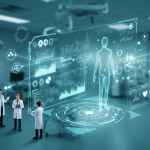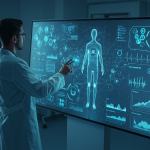Nimra Khan
Introduction:
Predictive analysis has been an integral part of healthcare for many years, enabling physicians to foresee the outcomes of their patients and make their treatment options more suitable as a result. Advanced AI technologies have now enabled predictive analysis to scale greater heights, transforming healthcare decision-making and improving patient care.
How AI in Predictive Analysis Evolved :
In the last few years, AI has revolutionized predictive analysis in healthcare. With the help of massive datasets, machine learning algorithms can now accurately predict disease outbreaks, patient outcomes, and treatment responses. This has enabled more proactive and personalized healthcare interventions.
Key Advancements in AI-Powered Predictive Analysis:
- Improved Disease Forecasting: AI programs can analyze complex data, such as genetic data, medical history, and lifestyle variables, to forecast the risk of developing diseases like cancer, diabetes, and heart disease. This makes it possible for early intervention and better management of chronic illnesses.
- Tailored Treatment Plans: Predictive analysis with AI makes it possible to design tailored treatment plans using unique patient information. With this, patients are provided with the most beneficial treatments best suited to their specific needs, optimizing outcomes and reducing side effects.
- Real-Time Monitoring and Alerts: AI systems can continuously monitor patient information in real time, sending alerts for possible health problems before they become critical. This feature is especially useful in the management of chronic diseases and avoiding hospital readmissions.
- Predictive Analytics for Public Health: AI is now employed to predict and control public health emergencies like epidemics and outbreaks of disease. Through multiple sources of data analysis, AI is able to predict the development and spread of contagious diseases so that interventions can be made promptly and resources appropriately assigned.
- Wearable Device Integration: The growing popularity of wearable health devices has generated a treasure trove of data for AI algorithms to process. Wearable devices can monitor vital signs, activity levels, and other health indicators, enabling AI to provide personalized health information and advice.
Real-World Applications:
- Early Cancer Detection at Memorial Sloan Kettering Cancer Center (MSKCC): In 2019, MSKCC launched an AI-driven predictive analysis system for early cancer detection. The AI model scans medical images to detect subtle alterations that may represent early-stage cancer, greatly improving patient outcomes and survival rates. MSKCC utilizes sophisticated imaging AI platforms like IBM Watson and Google Cloud Healthcare API.
- Predictive Analytics of Diabetes Management at Mayo Clinic: Mayo Clinic initiated an AI-based predictive analytics solution for diabetes management in 2021. The solution predicts blood glucose levels and recommends medication and lifestyle changes, enabling patients to have improved control over their disease. Mayo Clinic uses tools such as Microsoft Azure and IBM Watson Health for predictive analytics.
- Predictive Maintenance on Healthcare Equipment at GE Healthcare: GE Healthcare introduced an AI-powered predictive maintenance system for medical equipment in 2020. The AI system identifies equipment failures ahead of time so that downtime is minimized, and medical devices are always available for use. GE Healthcare uses the Predix platform for predictive maintenance.
- Hospital Operations Predictive Analytics at Johns Hopkins Hospital: Johns Hopkins Hospital introduced an AI-based predictive analytics system to streamline hospital operations in 2022. The system predicts patient flow and distributes resources effectively, minimizing wait times and enhancing overall hospital efficiency. Johns Hopkins utilizes Epic Systems and IBM Watson for operational analytics.
- Predictive Analytics in Public Health at the Centers for Disease Control and Prevention (CDC): In 2023, the CDC created a public health predictive analytics tool based on AI. The tool predicts and manages disease outbreaks using data from many sources, allowing for timely intervention and improved resource allocation. The CDC uses AWS (Amazon Web Services) and Google Cloud Platform for public health analytics.
- AI-Driven Drug Discovery at Tempus: In 2024, Tempus launched an AI-powered drug discovery and development platform. The platform employs machine learning to interpret genetic information and predict potential drug targets, speeding up the drug discovery process and minimizing development time.
- NVIDIA AI-Driven Cybersecurity: In 2025, NVIDIA introduced an AI-driven cybersecurity product for health organizations. The product employs machine learning to identify and prevent cyber attacks and maintain patient data security and regulation compliance such as HIPAA.
- RadNet’s AI-Powered Patient Monitoring: RadNet incorporated sophisticated machine learning algorithms into its imaging processes in late 2024. The AI system continuously tracks patient data, offering real-time insights and enhancing diagnostic accuracy.
Conclusion
AI predictive analytics is transforming the field of medicine with more precise predictions, tailor-made treatments, and anticipatory interventions. The horizon for utilizing AI technologies holds huge potential in bettering outcomes and revolutionizing the delivery of healthcare. A better future of healthcare is promised by leveraging smart usage of information and AI towards making a leaner, effective, and patient-focussed system.


